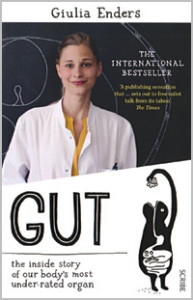Gut
The inside story of our body’s most underrated organ
by Giulia Enders.
Published by Scribe Publications www.scribepublications.co.uk
This is the fable of three brothers (I can just see the animated short now). They all start off as tiny tubes but rapidly grow and branch into complex players in the body. The first grows into the circulatory system (the heart) and gets all the love stories. The second grows into the nervous system (brain) and solves your problems. The third grows into the gut and no one ever talks about him again. Well, maybe not no one but he’s more the subject of crude jokes than polite conversation. ‘Gut’ by microbiology researcher Giulia Enders wants to end that ghettoisation and bring your best gut forward (sorry). If you’ve ever raised children or know anyone who’s raised children, you’re probably familiar with the ‘Everybody Poops’ book (and Family Guy’s Catholic guilt equivalent ‘Nobody Poops But You’). ‘Gut’ is ‘Everybody Poops’ for grown-ups.
You probably don’t think you need a book like this. After all, you’ve been managing perfectly well on you own for years. Or have you? Are you sitting comfortably? If you are reading this in the bathroom, probably not. Countries that use Western-style porcelain thrones have the highest rate of constipation and haemorrhoids due to the fact that a sitting position is not optimum for intestinal movement and requires us to place extra pressure on our various tubes and valves to overcome resistance. Worry not, Enders has a quick guide (with cute illustration – among many – provided by her sister Jill) to show you how to fix your poor pooping position.
Enders charming prose (translated from the German, so kudos to the translator) makes you look at the processes of your digestive system in a whole new light. She describe the unconscious muscle movements involved in breaking wind as ‘delicate and complex as those of a ballerina’ and vomiting as a ‘tour de force performance’ requiring complex interaction between many players. So next time you’ve had a ‘protein spill’ (Disneyland code) remember to follow it with a ‘Ta-da!’ and a little bow.
The process of eating and excreting and everything in between is not the whole of this book though that is a far more fascinating and clever story that I had assumed (things I learned: you have three tonsils, the reason your stomach is shaped like that, you excrete blood every day – and it’s a good thing). The second half deals with your microbiome – the 100 trillion bacteria that live in your intestine
“It maybe that…” and “probably” are phrases that show up a lot in ‘Gut’. The science of the gut has really only gotten stared over the last couple of years – the “wobbly milk teeth and short pants” stage as Enders puts it – as new diagnostic and research tools are only now revealing the hitherto unsuspected massive complexity of our bacterial buddies.
It turns out that you house an entire – and unique – ecosystem. Those trillions of bacteria aren’t just passive freeloaders but vital workers earning their keep. They digest food for you that you couldn’t otherwise break down, their distribution decides how effective your medications are, whether you’ll suffer from side-effects and whether you’ll grow fat or thin on the same diet (yes, you can have ‘chubbie’ bacteria!). The vast nervous system of the gut is second only to the brain in complexity and has direct connections to it. We don’t know what most of it does yet but ‘gut feeling’ may turn out to be a literal rather than figurative expression. Of course, not everybody is on board this new bacteria train but their objections have the whiff (again, sorry) of early germ theory deniers while this new bacterial paradigm the has the potential to make as great an impact.
Frankly I can’t believe I’ve been operating one of these things for years without instructions. ‘Gut’ is part cutting edge science, part DIY guide, part owners manual and definitely a recommended bathroom read.
